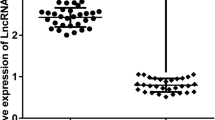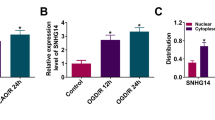Abstract
Endoplasmic reticulum stress (ERS) plays an important role in cerebral ischemia-reperfusion injury (CIRI) by regulating apoptosis. Although the role of long non-coding RNA (LncRNA) KCNQ1OT1 in CIRI has been reported, the specific mechanism is still unclear. In this paper, the regulation of ERS by LncRNA KCNQ1OT1 in CIRI and its mechanism were studied. Transient middle cerebral artery occlusion (tMCAO) model was established in SD rats with KCNQ1OT1 intervention. PC12 cells were used to construct the OGD/R cell model. The expressions of LncRNA KCNQ1OT1 and miR-30b were detected by RT-qPCR. TCC staining was used to detect the extent of cerebral ischemia. TUNEL staining was used to detect apoptosis level, and Western blot was used to detect the expressions of ERS and apoptosis-related proteins. The targeted binding of LncRNA KCNQ1OT1, miR-30b, and GRP78 was detected by double luciferase assay. The expressions of LncRNA KCNQ1OT1 and miR-30b were interfered by cell transfection. Cell proliferation was detected by CCK-8. The level of LncRNA KCNQ1OT1 was increased and that of miR-30b was decreased in the blood samples of patients with CIRI. In tMCAO rats with KCNQ1OT1 intervention, the expression of miR-30b was increased, and the ischemic range of brain tissues was decreased. What’s more, the level of ERS was decreased, and the apoptosis of brain tissues was decreased. LncRNA KCNQ1OT1 could regulate miR-30b/GRP78 in OGD/R cells in a targeted way. Intervention of KCNQ1OT1 could promote the proliferation of OGD/R cells, inhibiting the level of ERS and cell apoptosis. Further inhibition of miR-30b could reverse the effect of intervention of KCNQ1OT1. LncRNA KCNQ1OT1 regulates ERS to affect CIRI through targeting miR-30b/GRP78.








Similar content being viewed by others
Change history
10 February 2022
A Correction to this paper has been published: https://doi.org/10.1007/s10753-022-01636-x
References
Majid, A. 2014. Neuroprotection in stroke: past, present, and future. ISRN Neurology 2014: 515716.
Feng, L., H. Li, F. Li, S. Bei, and X. Zhang. 2020. LncRNA KCNQ1OT1 regulates microRNA-9-LMX1A expression and inhibits gastric cancer cell progression. Aging (Albany NY) 12 (1): 707–717.
Sun, H., Y. Sun, Q. Chen, and Z. Xu. 2020. LncRNA KCNQ1OT1 contributes to the progression and chemoresistance in acute myeloid leukemia by modulating Tspan3 through suppressing miR-193a-3p. Life Sciences 241: 117161.
Chen, L., et al. 2020. LncRNA KCNQ1OT1 accelerates fracture healing via modulating miR-701-3p/FGFR3 axis. The FASEB Journal.
Ren, Y., X.P. Gao, H. Liang, H. Zhang, and C.Y. Hu. 2020. LncRNA KCNQ1OT1 contributes to oxygen-glucose-deprivation/reoxygenation-induced injury via sponging miR-9 in cultured neurons to regulate MMP8. Experimental and Molecular Pathology 112: 104356.
Yu, S., M. Yu, X. He, L. Wen, Z. Bu, and J. Feng. 2019. KCNQ1OT1 promotes autophagy by regulating miR-200a/FOXO3/ATG7 pathway in cerebral ischemic stroke. Aging Cell 18 (3): e12940.
Gu, D., et al. 2016. Mesenchymal stromal cells derived extracellular vesicles ameliorate acute renal ischemia reperfusion injury by inhibition of mitochondrial fission through miR-30. Stem Cells International 2016: 2093940.
Li, S.P., J.D. He, Z. Wang, Y. Yu, S.Y. Fu, H.M. Zhang, J.J. Zhang, and Z.Y. Shen. 2016. miR-30b inhibits autophagy to alleviate hepatic ischemia-reperfusion injury via decreasing the Atg12-Atg5 conjugate. World Journal of Gastroenterology 22 (18): 4501–4514.
Song, C.L., B. Liu, J.P. Wang, B.L. Zhang, J.C. Zhang, L.Y. Zhao, Y.F. Shi, Y.X. Li, G. Wang, H.Y. Diao, Q. Li, X. Xue, J.D. Wu, J. Liu, Y.P. Yu, D. Cai, and Z.X. Liu. 2015. Anti-apoptotic effect of microRNA-30b in early phase of rat myocardial ischemia-reperfusion injury model. Journal of Cellular Biochemistry 116 (11): 2610–2619.
Ziu, M., L. Fletcher, S. Rana, D.F. Jimenez, and M. Digicaylioglu. 2011. Temporal differences in microRNA expression patterns in astrocytes and neurons after ischemic injury. PLoS One 6 (2): e14724.
Wen, Y., Y. Yu, and X. Fu. 2017. LncRNA Gm4419 contributes to OGD/R injury of cerebral microglial cells via IkappaB phosphorylation and NF-kappaB activation. Biochemical and Biophysical Research Communications 487 (4): 923–929.
Li, X., Y. Dai, S. Yan, Y. Shi, B. Han, J. Li, L. Cha, and J. Mu. 2017. Down-regulation of lncRNA KCNQ1OT1 protects against myocardial ischemia/reperfusion injury following acute myocardial infarction. Biochemical and Biophysical Research Communications 491 (4): 1026–1033.
Li, T., Z.L. Sun, and Q.Y. Xie. 2015. Protective effect of microRNA-30b on hypoxia/reoxygenation-induced apoptosis in H9C2 cardiomyocytes. Gene 561 (2): 268–275.
Louessard, M., I. Bardou, E. Lemarchand, A.M. Thiebaut, J. Parcq, J. Leprince, A. Terrisse, V. Carraro, P. Fafournoux, A. Bruhat, C. Orset, D. Vivien, C. Ali, and B.D. Roussel. 2017. Activation of cell surface GRP78 decreases endoplasmic reticulum stress and neuronal death. Cell Death and Differentiation 24 (9): 1518–1529.
Krebs, J., L.B. Agellon, and M. Michalak. 2015. Ca(2+) homeostasis and endoplasmic reticulum (ER) stress: an integrated view of calcium signaling. Biochemical and Biophysical Research Communications 460 (1): 114–121.
Cai, X.H., X.C. Li, S.W. Jin, D.S. Liang, Z.W. Wen, H.C. Cao, H.F. Mei, Y. Wu, Z.D. Lin, and L.X. Wang. 2014. Endoplasmic reticulum stress plays critical role in brain damage after chronic intermittent hypoxia in growing rats. Experimental Neurology 257: 148–156.
Tajiri, S., S. Oyadomari, S. Yano, M. Morioka, T. Gotoh, J.I. Hamada, Y. Ushio, and M. Mori. 2004. Ischemia-induced neuronal cell death is mediated by the endoplasmic reticulum stress pathway involving CHOP. Cell Death and Differentiation 11 (4): 403–415.
Duan, S.R., J.X. Wang, J. Wang, R. Xu, J.K. Zhao, and D.S. Wang. 2010. Ischemia induces endoplasmic reticulum stress and cell apoptosis in human brain. Neuroscience Letters 475 (3): 132–135.
Acknowledgments
The authors would like to thank all members in the Tianjin Medical University General Hospital lab for helpful discussions on the manuscript.
Funding
This work was supported by National Natural Science Foundation of China (81571172).
Author information
Authors and Affiliations
Contributions
All authors read and approved the final version of the manuscript.
Corresponding author
Ethics declarations
Ethics Approval and Consent to Participate
The study protocol was approved by the Tianjin Medical University General Hospital, and all patients provided written informed consent. All of the procedures were in compliance with The Declaration of Helsinki and relevant policies in China. All animal experiments comply with the ethical requirements of the animal council.
Competing Interests
The authors declare that they have no competing interests.
Additional information
Publisher’s Note
Springer Nature remains neutral with regard to jurisdictional claims in published maps and institutional affiliations.
Rights and permissions
About this article
Cite this article
Li, Y., Yi, M., Wang, D. et al. LncRNA KCNQ1OT1 Regulates Endoplasmic Reticulum Stress to Affect Cerebral Ischemia-Reperfusion Injury Through Targeting miR-30b/GRP78. Inflammation 43, 2264–2275 (2020). https://doi.org/10.1007/s10753-020-01295-w
Published:
Issue Date:
DOI: https://doi.org/10.1007/s10753-020-01295-w




